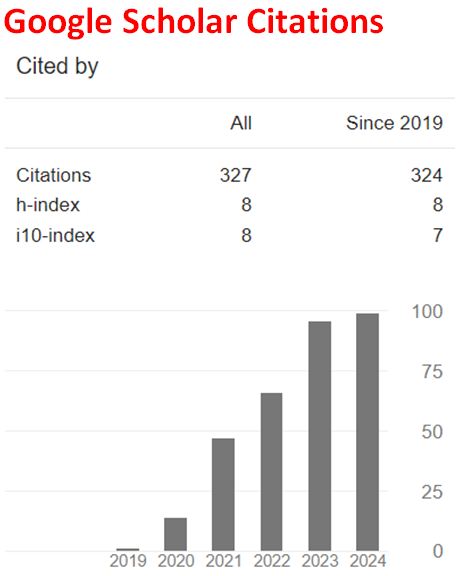Effect of zinc cation on thiobarbital and a perturbed thiobarbital – A DFT treatment
Abstract
In the present study, thiobarbital and a perturbed thiobarbital which is constructed from thiobarbital by means of certain centric perturbations have been subjected to effect of zinc cation in vacuum conditions within the constraints of density functional theory at the level of B3LYP/6-31++G(d,p). Various structural and quantum chemical data have been collected and discussed, including IR and UV-VIS spectra. The effect of Zn+2 resulted that in both of the structures considered an α-hydrogen of one of the ethyl moieties underwent a bond cleavage which seemed that it is more dramatic on thiobarbital.
Downloads
References
Kambe, T., Tsuji, T., Hashimoto, A., & Itsumura, N. (2015). The physiological, biochemical, and molecularroles of zinc transporters in zinc homeostasis and metabolism. Physiol. Rev., 95, 749-784. https://doi.org/10.1152/physrev.00035.2104
Jansen, J., Karges, W., & Rink, L. (2009). Zinc and diabetes - clinical links and molecular mechanisms. Journal of Nutritional Biochemistry, 20, 399-417. https://doi.org/10.1016/j.jnutbio.2009.01.009
Maret, W. (2008). Metallothionein redox biology in the cytoprotective and cytotoxic functions of zinc. Experimental Gerontology, 43(5), 363-369. https://doi.org/10.1016/j.exger.2007.11.005
Ranasinghe, P., Pigera, S., Galappatthy, P., Katulanda, P., & Constantine, G.R. (2015). Zinc and diabetes mellitus: understanding molecular mechanisms and clinical implications. DARU Journal of Pharmaceutical Sciences, 23(44). https://doi.org/10.1186/s40199-015-0127-4
Stamoulis, I., Kouraklis, G., & Theocharis, S. (2007). Zinc and the liver: An active interaction. Dig, Dis. Sci., 52, 1595-1612. https://doi.org/10.1007/s10620-006-9462-0
Grungreiff, K., Reinhold, D., Wedemeyer, H. (2016). The role of zinc in liver cirrhosis. Ann. Hepatol., 15, 7-16. https://doi.org/10.5604/16652681.1184191
Katayama, K., Kawaguchi ,T., Shiraishi, K., Ito, T., Suzuki, K., Koreeda, C., Ohtake, T., Iwasa, M., Tokumoto, Y., Endo, R., Kawamura, N., Shiraki, M., Hanai, T., Habu, D., Tsuruta, S., Sakai, H., Miwa, Y., Kawada, N., Kato, A., Takei, Y., Mine, T., Kohgo, Y., Seki, T., Sata, M., Ito, Y., Fukui , K., Nishiguchi, S., Moriwaki, H., & Suzuki, K. (2018). The prevalence and implication of zinc deficiency in patients with chronic liver disease. J. Clin. Med. Res., 10, 437-444. https://doi.org/10.14740/jocmr3374w.Epub
Cellular zinc metabolism and zinc signaling: from biological functions to diseases and therapeutic targets. Chen, B., Yu, P., Cha, W.N., Xie, F., Zhang, Y. Li, L. , Leung, K.T., Lo, K.W., Yu, J., Tse, G.M.K., Kang, W., & To,K.F. (2024). Signal Transduction and Targeted Therapy, 9(1), 6. https://doi.org/10.1038/s41392-023-01679-y
Amos, A., & Razzaque, M.S. (2022). Zinc and its role in vitamin D function. Current Research in Physiology, 5, 203-207. https://doi.org/10.1016/j.crphys.2022.04.001
Fischer, E., & Dilthey, A. (1904). Ueber C-Dialkylbarbitursäuren und über die Ureïde der Dialkylessigsäuren. Justus Liebigs Annalen der Chemie, 335(3), 334-368. https://doi.org/10.1002/jlac.19043350303
Carrington, H.C. (1965). The action of phosphorus pentasulphide on barbituric acids. Journal of the Chemical Society (Resumed), 1 to 7601. https://doi.org/10.1039/JR9440000124
Bartels, E.C. (1945). Use of thiobarbital in the treatment of hyperthyroidism. JAMA, 129(14), 932-935. https://doi.org/10.1001/jama.1945.02860480012003
Mansberger, A.R., Jr. (1988). One hundred years of surgical management of hyperthyroidism. Ann. Surg., 207(6), 724-9. https://doi.org/10.1097/00000658-198806000
Stewart, J.J.P. (1989). Optimization of parameters for semi-empirical methods I. J. Comput. Chem., 10, 209-220. https://doi.org/10.1002/jcc.540100208
Stewart, J.J.P. (1989). Optimization of parameters for semi-empirical methods II. J. Comput. Chem., 10, 221-264. https://doi.org/10.1002/jcc.540100209
Leach, A.R. (1997). Molecular modeling. Essex: Longman.
Kohn, W., & Sham, L.J. (1965). Self-consistent equations including exchange and correlation effects. Phys. Rev., 140, 1133-1138. https://doi.org/10.1103/PhysRev.140.A1133
Parr, R.G., & Yang, W. (1989). Density functional theory of atoms and molecules. London: Oxford University Press.
Becke, A.D. (1988). Density-functional exchange-energy approximation with correct asymptotic behavior. Phys. Rev. A, 38, 3098-3100. https://doi.org/10.1103/PhysRevA.38.3098
Vosko, S.H., Wilk, L., & Nusair, M. (1980). Accurate spin-dependent electron liquid correlation energies for local spin density calculations: a critical analysis. Can. J. Phys., 58, 1200-1211. https://doi.org/10.1139/p80-159
Lee, C., Yang, W., & Parr, R.G. (1988). Development of the Colle-Salvetti correlation energy formula into a functional of the electron density. Phys. Rev. B, 37, 785-789. https://doi.org/10.1103/PhysRevB.37.785
SPARTAN 06 (2006). Wavefunction Inc. Irvine CA, USA.
Richmond, T.J. (1984). Solvent accessible surface area and excluded volume in proteins: Analytical equations for overlapping spheres and implications for the hydrophobic effect. Journal of Molecular Biology, 178(1), 63-89. https://doi.org/10.1016/0022-2836(84)90231-6

This work is licensed under a Creative Commons Attribution 4.0 International License.


